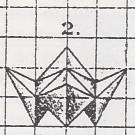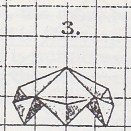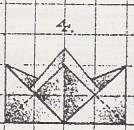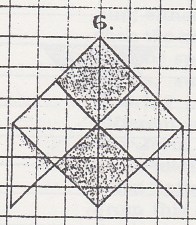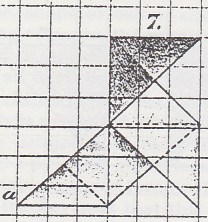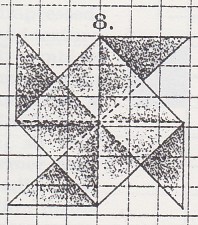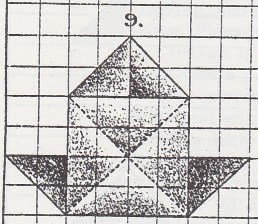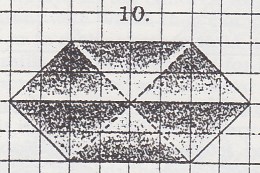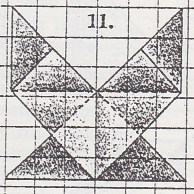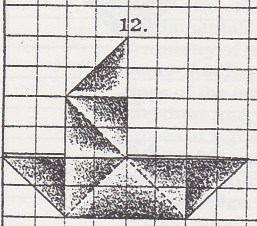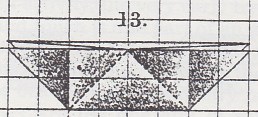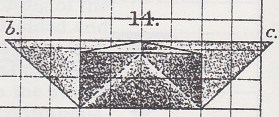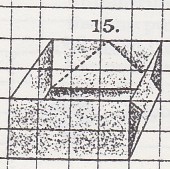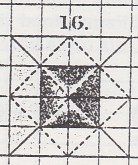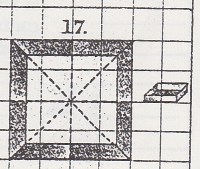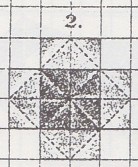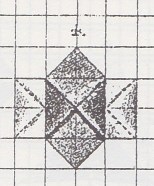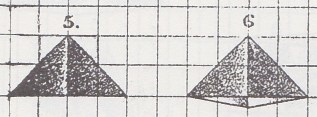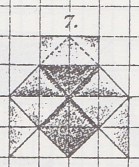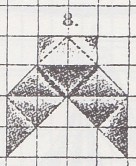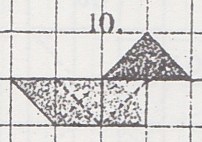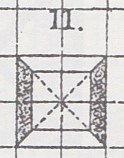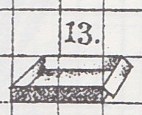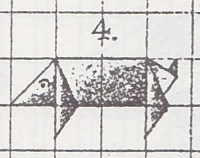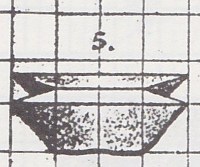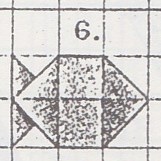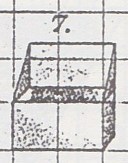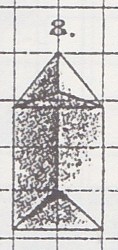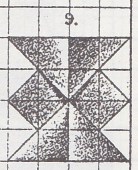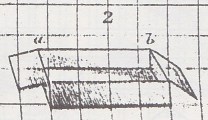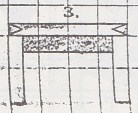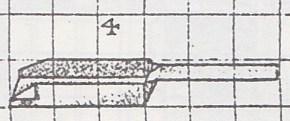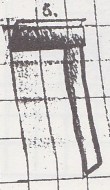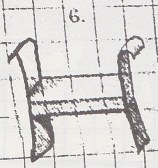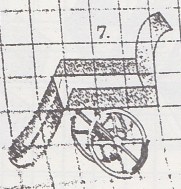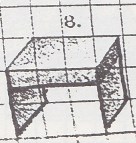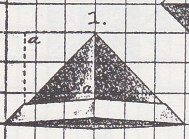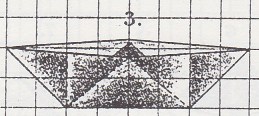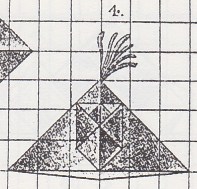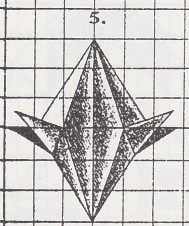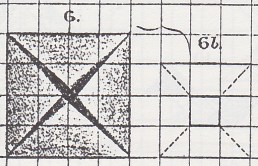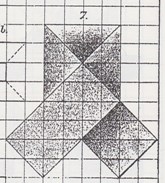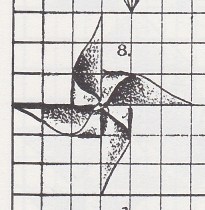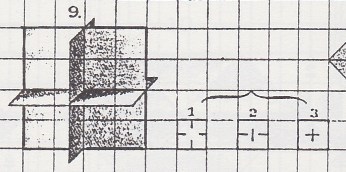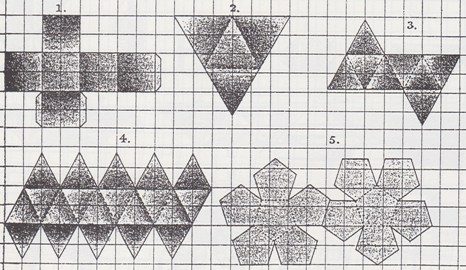| The Public Paperfolding History Project
Last updated 26/8/2024 x |
|||||||
| Course of Paperfolding by Eleonore Heerwart, 1895 | |||||||
| 'Course
of Paperfolding' by Eleonore Heerwart was published by
Charles and Dible in London and Glasgow. The work is not
dated on the title page but the Introduction is dated
1895. The work consists of an Introduction (a full copy of which can be found at the foot of this page), 33 Plates and an Explanation of them. The Figures from the Plates and the Explanation are interweaved in the Analysis. As well as illustrations of many paperfolds, the work contains much historical information about Froebel's own paperfolding and the way in which it was subsequently developed by other pedagogues. I have collected the important references to Froebel into a section about the extent and limitations of Froebel's own paperfolding (see below). The work also contains an advertisement for paperfolding related materials which can be purchased from the publisher. A copy of this advertisement can also be found at the foot of this page. A full copy of the work can be accessed online here. ********** This work is mentioned in Gershon Legman's 'Bibliography of Paperfolding' which was published in 1952.
It seems clear from this remark that Legman had not read the Introduction to this work, in which the Author stresses that the occupation of Paperfolding is one of innovation and discovery and not of sterile reproduction. the following quotes in illustration of this are taken from the Introduction. Thus
and
**********
********** Information about the extent and limitations of Froebel's own paperfolding Taken from the Introduction
**********
**********
********** Taken from the Explanation of the Plates Plate I
***
********** Plate III
********** Plate IV
********** Plaste V
********** Plate VIII
**********
********** Plate IX
It seems likely to me that there is a misprint here and that the first sentence should end after (forms of beauty). ********** A note on language and the names of groundforms The terms 'Folds of Life', 'blintzed', 'bronze rectangle' etc do not appear in the Author's original text. I have however used them in the Analysis as their meaning is widely understood. The Author refers to the three main groundforms, the blintzed square, the doubly blintzed square, and the triply blintzed square in several ways. The blintzed square - the Author says that Froebel did not call this fold a groundform. She, however, calls it either 'the simple groundform' or simply 'groundform A'. The doubly blintzed square - the Author says that Froebel called this 'the simple groundform'. She, however, calls it 'the double groundform' or simply 'groundform B'. These names appear to refer to all forms of the doubly blintzed square. However the Author does distinguish between them as: B1 - Side 1 of the Double Blintz Base, a square blintzed, turned over and blintzed again, which has four square flaps meeting at the centre B2 - Side 2 of the Double Blintz Base which has four triangular flaps meeting at the centre B3 - a square blintzed twice without turning it over in between the blintzes B4 - made from a square which is white one side and coloured on the other. The corners of the square are blintzed alternately backwards and forwards, then blintzed again, all corners moving forwards. On the side where the triangular flaps are white the paper is pulled out from inside the blintzes to form flaps that are like those of a Windmill Base, except there are only two not four of these. B5 - I cannot see how this groundform is to be constructed. B6 - I cannot see how this groundform is to be constructed. B7 - The Windmill. B8 - what we now call the Windmill Base. The triply blintzed square - the Author says that Froebel called this 'the double groundform'. She, however, calls it 'the treble groundform' or simply 'groundform C'. The author also mentions a fourth groundform developed by August Kohler which she calls 'groundform D' and which I call 'Kohler's groundform'. Plate VII introduces three octagonal groundforms from which Folds of Beauty can be developed. ********** Analysis In the work some illustrations of elements of the Course of Paperfolding are to be found spread across several Plates. In this Analysis I have brought these elements together so that the content is more easily understood. Consequently, illusrtrations are not necessarily presented in the order in which they appear in the work. ********** Froebel's method of cutting four squares from a rectangle
********** The Visual Index
********** Basic Folds and Groundforms - Plate I This Plate illustrates some basic folds and Froebel's system of groundforms from which Folds of Life and Folds of Beauty can be developed. The author states that Froebel called fig. 20 (the doubly blintzed square) the simple groundform and fig 24 (the triply blintzed square) the double groundform but that since 1862 she has referred to fig 16 (the blintzed square) as the simple groundform, fig 20 as the double groundform and fig 24 as the treble ground form. She also indicates that children may see various figures as Simple Folds of Life, fig 3 - a book, fig 9 or 10 - a tent, fig 14 - a house and fig 16 - an envelope.
ie 'on Plate II' There is no indication that the paper is to be turned over in between each sequence of blintzes to create the Doubvle blintz or Triple blintz bases.
********** Folds of Life from Froebel's Simple Groundform - Plate II
2. The Salt-Cellar - The Salt Cellar
******** 3. A workbasket - The Pepperpot
********** 4. A Crown - The King's Crown
********** 5. A Bag - The Travel Bag
********** 6. The Fish (plaice) - The Squid
********** 7. The Bird (cock or crow) - The Cocotte / Pajarita
********** 8. The Sails of a Windmill - The Windmill
********** 9. A Boat with House - The Ship
********** 10. A Cigar-Case - The Cigar Case
********** 11. A Flower-Stand - The Vase
********** 12. A Boat with Sail -The Boat with Sail
********** 13. A Double boat - The Double Boat
********** 14, A Boat with Fishbox - The Boat with Fishbox
********** 15. Box - The Large Box The text mentions that the box may have a cover of the same design.
********** 16. A Frame of a Picture - The Frame
********** 17. A Box with Low Sides - The Solid Box
********** Folds of Life from Froebel's Double Groundform - Plate III
Folds of Life from the Treble Groundform ie The Third Groundform 2. |The Cross - The Cross
********** 3. The Scent-Bottle - The Scent Bottle
********** 4. The Muff - The Muff
********** 5. The Boots - The Boots
********** 6. The Hat - The Pyramidal Hat Misplaced in the sequence of designs because it belongs to the figure (ie The Doll) of which the Author says:
********** 7. The Jacket - The Jacket
********** 8. The Trousers - The Trousers
********** 9. A Double Boat - The Double Boat
********** 10. A Duck - The Duck
********** 11. A Frame - The Picture Frame
********** 12. An Hour Glass - The Looking Glass
********** 13. A Box with Lid - The Junk Box
********** Designs from Kohler's Groundform - Plate III
2. A House-Boat - The Cup and Saucer
********** 3. A Handkerchief Case - ???????
********** 4. The Celebrated Pig - The Pig
********** 5. A Double boat - probably Another Double Boat
********** 6. A Fish - The Fish
********** 7. A Chair - The Bench with Arms
********** 8. A Bracket - The Corner Cabinet
********** 9. A Letter Rack - The Yarn Spool
********** Designs from oblongs - Plate III 2. A box - The Basic Box
********** 3. A Trough - Probably The Stand
********** 4. A Shovel - The Shovel
********** 5. A Hammer - ???????
********** 6. A Bench - The Seat
********** 7. A Wheeled Chair - The Bathchair The wheels need to be made from cardboard
********** 8. A Table (made like 2) - The Piano Stool
********** Miscellaneous designs (from the Keilhau list of objects written down in 1853) - Plate IV
The words 'These miscellaneous objects ... were known before Froebel raised Paper-folding into an educational method' imply that by contrast the Forms of Life pictured on the preceeding plates were not known before Froebel's time. ********** 1. A Hat - The Newspaper Hat
********** 2. The Pencil Case - The Pencil Case
********** 3. The Boat - The Paper Boat
********** 4. The Hat - The Soldier's Cap
********** 5. The Bellows - The Bellows
********** 6. The Secret Letter - The Puzzle Purse
********** 7. The Open Letter - The Love Knot Letterfold
********** 8. The Windmill - The Cut and Fold Windmill
9. Ornament for a Christmas Tree - The Slit and Assemble Cube
********** Cut and Fold Polyhedral Nets - Plate IV
********** Geometrical Folds - Plate V
Unfortunately there are contradictions in the numbers of the various figures attributed to August Kohler and E Heerwart here. Figures 13, 14 and 21 are attributed to both. Figure 15 is attributed to Miss Steele. It may be that a comparison with Kohler's own writings may resolve these contradictions. Geometrical folds said to have been introduced by August Kohler
********** Geometrical folds said to have been introduced by Miss Steele
********** Geometrical folds said to have been introduced by E Heerwart
**********
********** Folds of Beauty from The Blintzed Square - Plate VI and Plate VII
********** Folds of Beauty from Kohler's Groundform - Plate VII
********** Folds of Beauty from Side 1 of the Double Blintz Base. It seems likely to me that there is a misprint here and that the first sentence should end after (forms of beauty).
These designs are folded Side 1 of the Double Blintz Base (which has four square flaps meeting at the centre). The Author designates this as groundform B1.
********** Folds of Beauty from Side 2 of the Double Blintz Base. These designs are folded from Side 2 of the Double Blintz Base which has four triangular flaps meetinmg at the centre. The Author designates this as groundform B2.
********** Folds of Beauty from the doubly blintzed square These designs are folded from a square which has been blintzed twice without being turned over. The Author designates this as groundform B3.
********** Folds of Beauty developed from groundforms B4 to B7
********** Designs from Groundform B4 Groundform B4 is made from a square which is white one side and coloured on the other. The corners of the square are blintzed alternately backwards and forwards, then blintzed again, all corners moving forwards. On the side where the triangular flaps are white the paper is pulled out from inside the blintzes to form flaps that are like those of a Windmill Base, except there are only two not four.
********** Designs from Groundform B5 I cannot see how the groundform for these patterns is to be constructed
********** Designs from Kohler's Groundform It appears to me hat there is an error in the work at this point. These designs appear to be constructed from Kohler's groundform rather than groundform B6 (whatever that may be) as stated in the text. Note the lack of shading, indicating that all visible parts of the design are from the same surface of the paper.
********** Designs from Groundform B7 - The Windmill
********** Folds of Beauty from Groundform B8 - The Windmill Base
********** Folds of Beauty from Octagonal Groundforms The Plate referred to immediately below is Plate VIII
Picture 5 shows a new groundform made by folding an octagon onto a blintzed square and tucking the corners inside the layers, which can then be used as the basis of Folds of Beauty. The text relating to Plate V, Fig 16, stated this was an invention of the author's.
********** How to use templates to construct hexagons, 60/120 rhombi and equilateral triangles in quantity The text also explains how to construct a Bronze Rectangle from a 60/120 rhombus by folding all corners to the centre, although the term Bronze Rectangle is, of course, not used.
********** Folds of Beauty from Equilateral Triangles
**********
The shading on Figure 2 appears to be incorrect.
********** Folds of Beauty from Hexagons
Figure 1 shows the result of folding all the corners folded to the centre in turn. The other designs are produced by first folkding three corners to the centre to produce a triangle.
********** Folds of Beauty from the 60/120 Rhombus
********** Folds of Beauty from Pentagons
**********
Figure 1 shows a design made by folding each of the corners of the pentagon inwards in turn.
********** Folds of Beauty from Cut Circles
********** Combinations of Geometric Forms
Note that figure 5 on Plate XXIX is a heptagonal star.
********** Getafel Formen - designs made by treating Forms of Beauty as tiles
**********
********** Exercises for inventions and ingenuity
********** Introduction and Advertisement
**********
********** |
|||||||





















